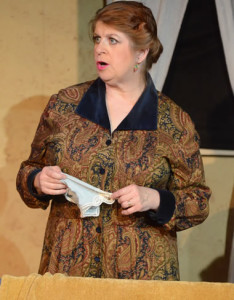Compass Rose Theater’s production of The Diary of Anne Frank, directed by Steve Tobin, is a powerful piece of theater, recounting one of the saddest stories of World War II. Strong acting and directing, as well as a striking set by Joann Gidos and creative lighting by Alex Brady, help make the play a moving account of ordinary people in an extraordinary situation.

The play, written by Frances Goodrich and Albert Hackett, first appeared in 1955. It won both the Tony Award for best play and Pulitzer Prize for Drama in 1956. According to the production notes, Lillian Hellman had originally been asked to adapt Anne Frank’s book. She instead recommended Goodrich and Hackett for their “lighter touch.” This production has many such touches, important to help bring a little humor to what would otherwise be an oppressively dark tale.
In 1942 Anne (Mia Goodman) moves into hiding with her parents (Steve Lebens and Alicia Sweeney) and older sister Margot (Jenny Donovan), into an attic over Mr. Frank’s business. They are joined by fellow Jews Mr. and Mrs. Van Daan (Bryant Centofanti and Jill Kyle-Keith) and their son Peter (Eli Pendry). Later, Mr. Dussel (Edd Miller), another Jew escaping the Nazi roundup, joins the attic. They remain there until captured in 1944. It is a memory play, bookended by Mr. Frank’s (Steve Lebens) return to the attic where he finds Anne’s diary recounting their time in hiding.
Because there is construction in the building during the day, during that time they must keep absolute silence, and never leave the attic, relying on their benefactor Miep (Rachael Murray) to come up daily with food and other supplies. Even at night they must be careful, as any loud noise (such as Anne’s nightmares), could attract unwanted attention from the street.
Goodman plays an Anne full of energy. At the start, she constantly runs around the attic and lays on the floor. Her impulsive movement causes trouble when she accidentally spills milk on Mrs. Van Daam’s fur coat, leading to a gasp from at least one audience member.
She is also extremely talkative, leading Peter to nickname her “Ms. Quack-Quack.” Being the two youngest, their relationship soon changes from frustration to a kind of romance, with Anne spending long periods of time in Peter’s room, to the consternation of both sets of parents.
Lebens’ Mr. Frank is a remarkable portrayal of a man staying calm under incredible pressure. He offers wisdom and tries his best to keep the peace. At one particularly low point, he remarks, “The Nazis didn’t destroy us, we’re doing it to ourselves.” His bond with Anne is especially strong. After waking from a nightmare, he comforts her. They seem more like friends than father and daughter.
Sweeney as Mrs. Frank struggles to create a sense of normalcy in an extraordinary situation. Late in the play she has an emotional moment that reveals just how difficult it has been for her to keep things together. Her relationship with Anne is complicated. She wants her youngest daughter to be a “proper young lady” like Margot, while Anne is wild and independent, with dreams of her own.
Pendry is a joy to watch as Peter. He begins the play shy and awkward, “a lone wolf” as he puts it. He has a fierce boldness at times, though. At the start, he removes the yellow star pinned to his jacket and wants to burn it. When Anne is uncertain about taking such a step herself, he questions her for not wanting to destroy something she “was branded with, something other people forced you to wear.” Seeing his growing relationship with Anne gives hope in a bleak scene. Towards the end, together in his room, he wraps his arms around her waist.

Centofanti and Kyle-Keith do a remarkable job with the Van Daans, well-off, assimilated Jews who consider themselves Dutch suddenly confronted with the possibility of death. They argue like a long-married couple, with Mr. Van Daan tired of hearing how many suitors his wife had when she was young. He makes a decision one night that almost tears this little community apart, then weeps over the near-destruction he creates.
The actors’ reactions when they hear a noise below during a Hanukah celebration is of sheer terror, fearing the worst and not knowing what to do. In the course of two hours they leap from joy to despair, hope and sorrow, showing the best and worst of humanity.
Joe Powell’s set helps bring the claustrophobia of so many people living in such close quarters, forced to remain quiet, to life. It is divided into three tiers, the first one the “common room” with a small couch that pulls out into a bed for Mr. and Mrs. and Margot Frank, along with chairs, small tables that can combine into one large dining room, and a sink. Above and to the right is a small room with two beds for Anne and Mr. Dussel. Above that are two lofts, one for Mr. and Mrs. Van Daan and, the other, facing a skylight, is Peter’s room.
The costumes by Beth Terranova have an authentic, 1940’s feel, with the men and women all dressed up even when they only see the nine of each other. There are numerous costumes changes, as the cast dresses for sleep and each new day; they make the changes swiftly. At the beginning they also wear the yellow star marking them as Jewish, a quiet yet forceful reminder of the measures the Nazis took to identify those they wished to oppress.

With such a large cast, all engaged in different stage business, Brady’s lighting helps keep focus on the main action. It also helps mark the transition from day to night.
Tobin has done an excellent job directing, with the actors’ movements across the stage feeling natural, and never crowding each other despite the tight quarters.
Mr. Frank’s last words, said in reference to Anne, are “She puts me to shame.” It is a powerful line in a moving drama at Compass Rose Theater that should not be missed.
Running Time: Two hours, with a 10-minute intermission.
The Diary of Anne Frank plays through Sunday, April 17, 2016 at Compass Rose Theater – 49 Spa Road, in Annapolis, MD. For tickets, call the box office at (410) 980-6662, or purchase them online.
RATING:





